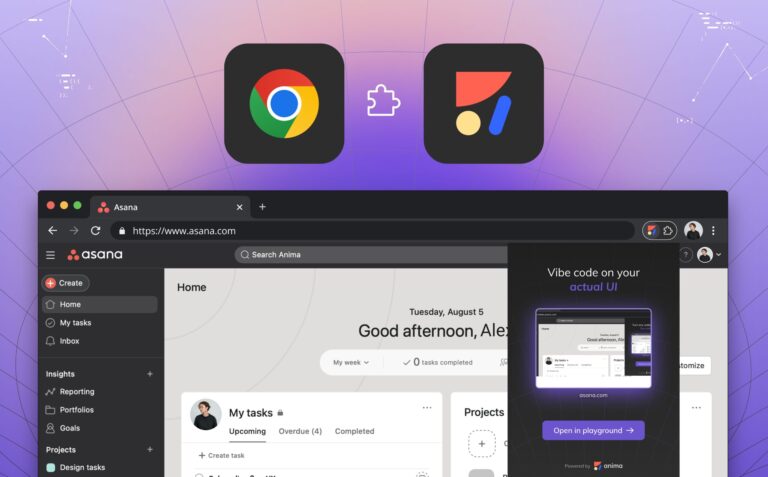Why New Year resolutions suck – a designers guide10 min read
Reading Time: 8 minutesLet’s face it, we’ve all been there (that’s if you’re not there right now 😉) – “New Year, new me”. But we all know that keeping these New Years’ resolutions, no matter how well-intended they may be, is just not realistic.
I mean think about it, we don’t just make radical changes because we’ve turned a page in our calendar and now it’s Jan 1st. This is probably why (unsurprisingly), 80% of New Year’s resolutions are no longer on people’s radar come mid-February.

Why do we wait until January 1st to make a change?
As designers, we are not immune to this ‘New Year, new me’ phenomenon. But why are we destined to fall off the wagon?
Here we’ll dive into the main reasons experts say our resolutions don’t stick, along with some common commitments we designers make (and break) each year. But don’t be discouraged!
We’ll also give you some actionable tips for managing your New Year’s goals and expectations—along with a game-changing resolution you’ll actually keep.
The 4 biggest reasons we don’t stick to New Year resolutions
We’ve all told ourselves at one point or another “this year, I’m going to cut back on my coffee consumption,” or “I’m going to spend the mornings meditating before starting the day,” or “I’m going to polish my UX portfolio”, and the list goes on.
That initial motivation is like the honeymoon period. It’s easy to get yourself ramped up because you’re thinking about the final result rather than the process. Having the motivation stick around requires real commitment, and without it, the fire will burn out.
Sound familiar? It’s okay. You’re only human, and you’re definitely not alone. The following four points explain why commitment fizzles out, and what that might look like for you as a designer.
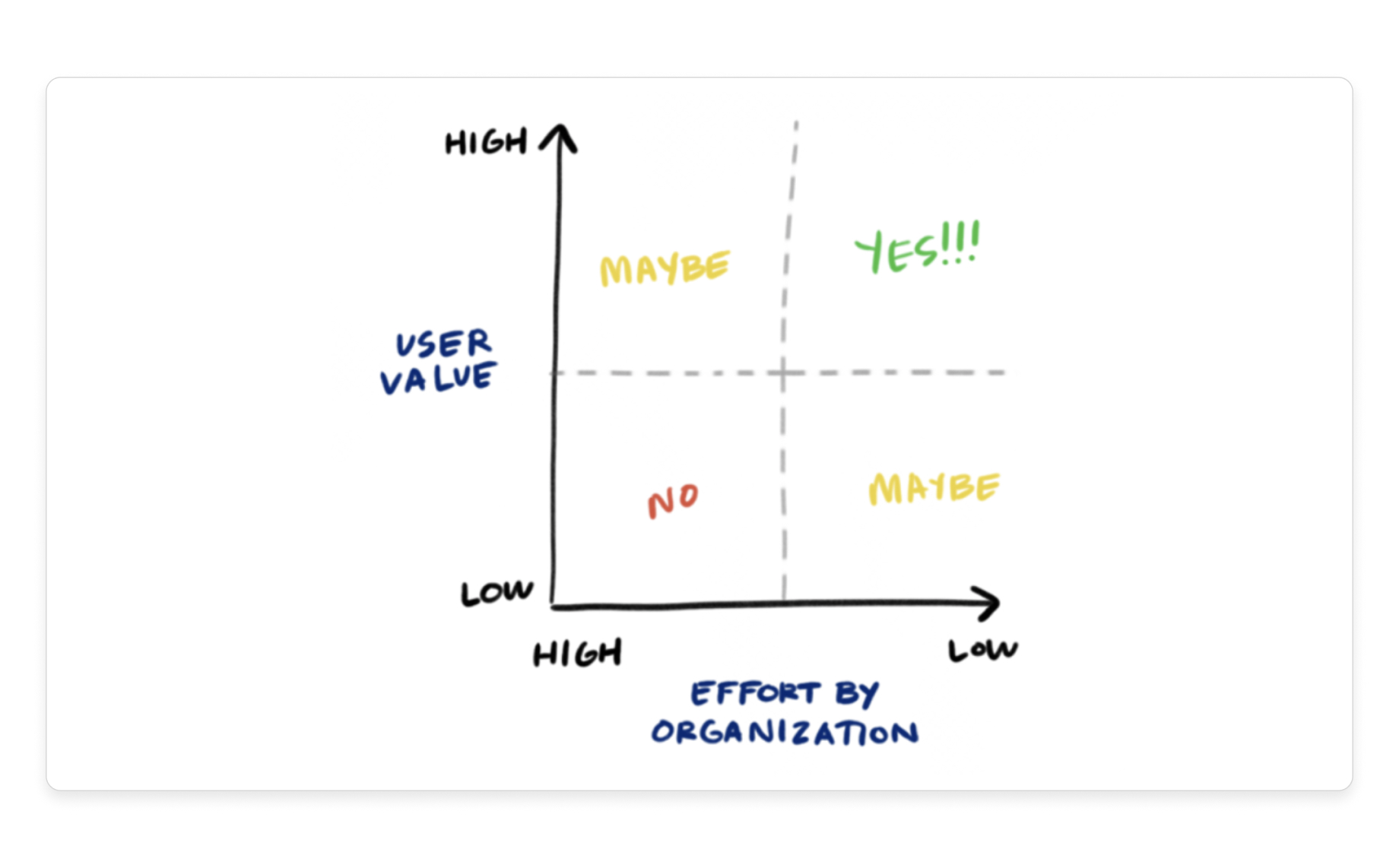
Prioritization matrix showing the effort & users’ value (source)
1. You are a procrastination god/dess
We have ample opportunity to make progress every day—not just on January 1st. But it is in our nature to push things off, make excuses why now is not the time, and assure ourselves we’ll do things later. So what better time than the New Year, right? Erm, well, actually, wrong!
We tell ourselves that we “just don’t have the time.” What we’re actually saying, however, is that it’s not a top priority. Don’t worry, we’re all guilty of it!
What designers tell themselves:
“I will start naming my Figma layers properly”
…and then we don’t. It’s funny because it’s true. We tell ourselves this all the time.
Here, I’ll pitch you the scenario:
- You got the brief from the higher-ups
- You start working on a design idea, pitch it to decision-makers, and get it approved—great!
- Now you need to build it, you want to create breakpoints, so you need to design it for all screen sizes – oh my, there’s so much still left to do!
- Now it’s crunch time, and you need to go back and name all of your layers. Properly.
- You look at the screen, and then at the clock, and then back at your screen. You know naming these damn layers will take an entire day (and who’s got time for that?).
- You set off on your naming mission. You start off strong (let’s call the first few hours “January”). Then 6 hours later (let’s call this point in your process “mid-February”) you say to yourself, “I’ll just name it something quick and temporary and fix it later…
- Poof. Before you know it, this resolution is out the window. You’ve got another task/approaching deadline and more work to do, and naming your layers is not an immediate priority.
- Now it really is March and you’ve fallen off the wagon. You’re back to naming your layers things like “component # 47.” But don’t fret, you’ll start naming your layers properly next year 😳.
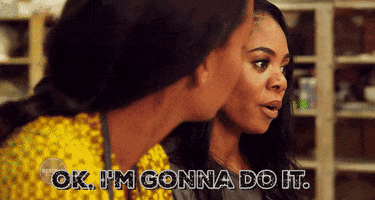
2. It’s the ‘Oliver Twist Syndrome’
This one is based on Charles Dickens’s classic novel and film adaptation, Oliver Twist. Oliver is born into a life of poverty and spends his childhood in an orphanage. In one of the most famous scenes ever, a hungry Oliver Twist begs the orphanage’s cold-hearted director for more food. “Please sir, may I have some more?” he exclaims. Predictably, his plea fails and he is punished for his “gluttony.”
It’s human nature to want more once we have received (or in the case of design goals, achieved) a taste of success. So we set ourselves a whole bunch of unreasonable goals at once, and it sets us up for failure.

The Oliver Twist Syndrome - we're always wanting more (source)
What designers tell themselves:
“This year, I’ll learn to code”
I can’t tell you how often I hear this one. Every designer wishes they could code, and every product manager wishes they could hire one person for both roles.
Why is this? Because it gets the whole product team speaking the same language and eliminates the clunky back-and-forth between designers and developers. But let’s keep it real. If you can’t find the time to name your layers properly, are you really going to find the time to learn to code? I’m not saying that designer-developers don’t exist, but they’re called ‘unicorns’ for a reason!
We’re in constant competition to learn and do more in the face of never-ending projects and excruciating design handoffs. If that’s not enough, decision-makers pile on impossible deadlines and unrealistic expectations.
Sometimes we can only address what’s in front of us, and if you’re like me, you probably won’t be learning to code anytime soon. So let yourself off the hook and lean into what you’re already great at!
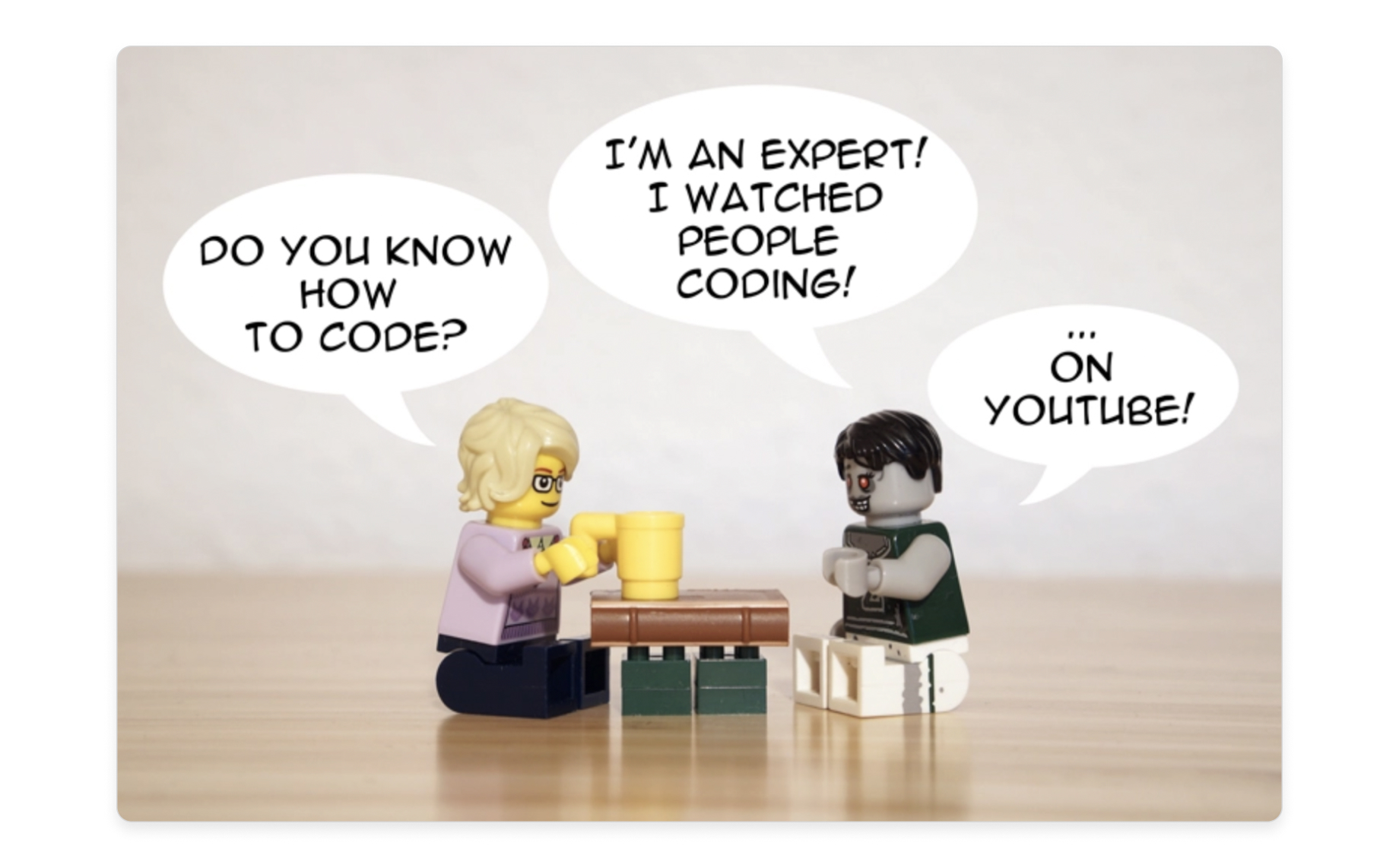
I'm gonna do it, I'm gonna learn to code - are you though? (source)
3. You’re people-pleasing
This is a big one, and I can’t emphasize it enough.
Making New Year’s resolutions to please others will not work.
What are your teammates and other design friends gnawing at you to do? Name your Figma layers properly? 🤭 (nope, this one is actually on you!) Stop following trends and be more creative? Be more patient with your developer? (I hope your developer’s new resolution is to be more patient with his or her designer).
Granted, these are all great ideas. But if they’re not your ideas, you won’t be as invested in bringing them to life.
So be sure to identify why you are committing to something—the reasons it’s important to you and the ways it might help you grow personally or professionally. Keep your own motivations front-and-center, and you’ll be more likely to stick to your resolutions.

"You can't please all the people all the time" - you're not pizza (source)
What designers tell themselves:
“I will keep up to date with new trends and new tools”
We all strive for this utopic world where we have time to get up in the morning, have coffee, do a sun salutation, pop in the shower, go to work, open our computers, and design the perfect app before lunchtime. Then we can spend the rest of the day learning every new design trend and finish early enough to beat the traffic home… Who wouldn’t want that?
The truth is, we all want to learn more so we can be more productive. But we also want to make our deadlines. So it doesn’t help when others keep telling us “you should really take some time to research new industry trends, so you can be more productive.”If we could, we would.
Honestly—how much of this resolution really comes from the heart if you’re already overwhelmed by everything else on your plate?
4. It’s all about self-belief
We make New Year’s resolutions because we want to better ourselves and our situations. We want it so much we aim a little too high for a first reach, and the failure to follow through bruises our confidence.
Think of it like this: you want to lose weight and you set a goal of 30-pounds. That’s an overwhelming amount of weight to lose in one go, and you won’t “succeed” until you reach it. That’s not to say you can’t lose 30 pounds, but if you set yourself a series of attainable goals like losing 5 pounds at a time, imagine how much more motivated you would be to keep working at it. Look at your big picture ambitions and break them down into bite-sized goals, then enjoy the confidence you’ll gain every time you achieve one. Before you know it, you’ll have made huge strides forward.
What designers tell themselves:
“For 2022, I will be more creative and have ideas all the time”.
We all strive for perfection, but we’ve already established that this sets us up for failure. When we set unattainable standards that feel overwhelming from the get-go, we can find ourselves (naturally) paralyzed by the weight and complexity of our goals. This can really hurt our self-esteem. Before we know it, you find your monkey mind nagging away at you literally pushing you away from your own success, and like most people, this makes us put our personal growth on hold instead of simply establishing more attainable goals.
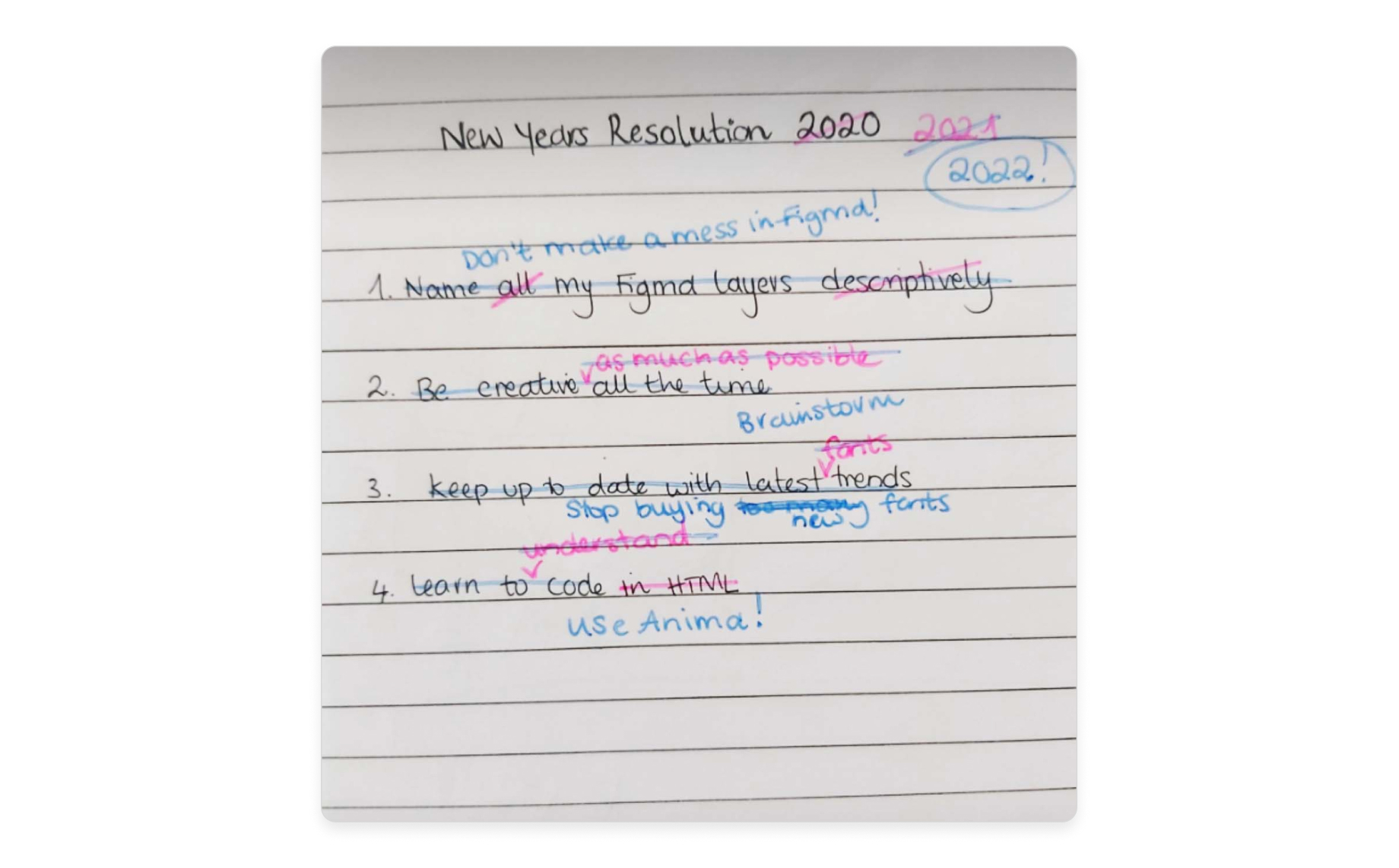
New Year resolutions of a UX designer 2020, 2021, 2022...
So what are you supposed to do?
So there are a bunch of things you want to accomplish in 2022. It is a New Year and there is no time like the present to get yourself together and build up the motivation. But after reading this article, you are probably thinking “what am I supposed to do?”
Here are a few simple tips to set you on the right track:
- Identify your priorities: Assess everything on your plate, and identify what’s most important and critical to your success
- Set one realistic and achievable goal: Keep it simple and manageable, and re-evaluate once you’ve reached it. A collection of smaller goals will ultimately help you realize your larger ambitions.
- Be honest with yourself and your boss/clients: We can’t stress this one enough. Set reachable deadlines, explain the process to decision-makers, and allow yourself spare time for personal and professional growth.
- Silence your inner critic: Be nice to yourself, and don’t set unreasonable objectives that make you feel like a failure (because you are, in fact, totally awesome).

In a sea of New Year’s resolutions you won’t keep, here’s one we know you will
Even with awareness of our human flaws, we will set ourselves resolutions that we are not going to stick to, just because it’s the beginning of a new calendar year. So with that in mind here is one New Year resolution as designers that you can adopt, and we know would be hard to give up on.
What designers should be telling themselves:
“For 2022, I am going to start using Anima!”
Why Anima is easy to stick to:
- It works in your existing design tool, but with the added functionality to create high-fidelity prototypes (remember the “learn new tool resolution” that won’t stick? Well no need here, cause Anima works in Figma, XD, and Sketch)
- It improves the designer-developer handoff by sending over your design to your developers as code they can really work with (so now you really can start to bond with your developer)
- You can create illusions and effects such as Parallax, live text and dropdown menus, embed code and so much more, from inside your design tool
- You can integrate other tools such as Hotjar, Intercom, and Fullstory, for a more holistic workflow and more effective user testing
- It has a free package, so what are you scared of?
Ready to start 2022 with a design bang?
- Sign up to Anima
- Download Anima plugin for Figma, Adobe XD, and Sketch
- Learn quickly with Anima’s 101


 Figma
Figma Adobe XD
Adobe XD Blog
Blog
